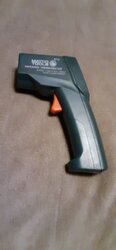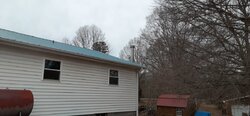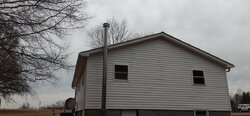Heavy creosote build up
- Thread starter Zombie
- Start date
-
Active since 1995, Hearth.com is THE place on the internet for free information and advice about wood stoves, pellet stoves and other energy saving equipment.
We strive to provide opinions, articles, discussions and history related to Hearth Products and in a more general sense, energy issues.
We promote the EFFICIENT, RESPONSIBLE, CLEAN and SAFE use of all fuels, whether renewable or fossil.
You are using an out of date browser. It may not display this or other websites correctly.
You should upgrade or use an alternative browser.
You should upgrade or use an alternative browser.
Check chimney height against stove manufacturers recommendations; there is no way the wood is dry enough, let alone in rounds of that size. Oak takes minimum 2 years, the others I’d guess at least a year in your climate. Buying wood also rarely remedies this situation, it is what it is. I think begreen is right a baffle might help a tiny bit but all in all the stove is and older model with no secondary systems, your going to burn on the dirty side and have creo build up. The soot water is good you won’t be disappointed with it. As far as your main issue/question, properly season the wood, wet wood will build creo fast. Also, unless you got a real good close up look at all of that pipe, don’t take shining a light up and seeing it at the other end as there’s no glaze in there. Good luck.
I don't have a flue pipe damper installed in this setup, but I am going to get 1. I set both damper knobs at wide open when loading and monitor temps then dial it back slowly to 1 full turn open to level it out and get it cruising, any further closed than 3/4 of a turn open and the thermo drops below 300. I haven't seen any moisture coming out of the wood but did hear some sizzle with 1 load. On a horizontal line it measures just over 10'. I have another 4' section of pipe I haven't added yet. The main reason for getting a load of wood was because I only have about 1 cord on hand, and I know that it's no quite ready to burn.Other than wet wood, no one has mentioned operator error.
Are you using a flue pipe damper?
How far are you closing the air dampers overnight?
You mentioned the pipe thermometer reading 300 - 400, but is it always that hot when smoke is present?
Do you hear any sizzle or hiss? Any moisture coming out of the ends of wood?
Last edited:
kennyp2339
Minister of Fire
Flue or stove top?I'm not going to comment on the wood, you seem to know whats going on with that, but you have to get those temps hotter, cruise around 500-600 for a cleaner burn.
kennyp2339
Minister of Fire
stove top, but you may see those temps or slightly higher temps on your single wall black pipe since you dont have a baffle in the stove or a pipe damper in the chimney, It wont hurt anything running that warm.Flue or stove top?
Soot Eater makes a great chimney cleaner, Pretty cheap as well.I hope it is, the guy says it is ready to burn and I will be checking it when he delivers it. OK, I will make sure no salt based logs. Suggestions on a good sweep brush?
Without baffle the rear top gets hotter than front. The front is more of simmer. With baffle the front becomes hotter which is what you want to stabilize temperature spikes up the stack.Also, on the grandpa bear, where would be the ideal location for a thermo on the stove top?
I always put it on the step so it’s easy to read instead of laying flat on the top.
The graduations and heat zones are for single wall pipe. You have to know what the temps are at different points in the system for creosote formation.
The surface temperature of pipe is about 1/2 the actual flue gas temp. With a baffle I get 250 on the pipe before entering chimney and 500 stove top. So 500 stove top correlates to 500 internal flue temp which would cool in some chimneys to 250 at top, hence the cool zone mark on thermometer at 250. Since each system cools differently, the thermometer is only a guide.
An IR surface thermometer is a great investment. At operating temperature with screen removed you can get an actual temp reading a foot down on the flue sidewall and see what that corresponds to on the pipe surface at bottom. Then you know where to run it without guess work. You’ll find drastic temperature differences on different parts of the stove too. Since the BTU output is determined by the temperature of each square inch of surface area, you get a good idea of how complicated it is.
Ok, that's what I have been seeing. I have seen as high as 650ish on the step of the stove, pipe temps at that time were a little over 375, I try to maintain 300 on the stove pipe.stove top, but you may see those temps or slightly higher temps on your single wall black pipe since you dont have a baffle in the stove or a pipe damper in the chimney, It wont hurt anything running that warm.
I have matched this against the magnetic thermos and they aren't that far off. Here are a couple more ahots of the chimney from different angles.Without baffle the rear top gets hotter than front. The front is more of simmer. With baffle the front becomes hotter which is what you want to stabilize temperature spikes up the stack.
I always put it on the step so it’s easy to read instead of laying flat on the top.
The graduations and heat zones are for single wall pipe. You have to know what the temps are at different points in the system for creosote formation.
The surface temperature of pipe is about 1/2 the actual flue gas temp. With a baffle I get 250 on the pipe before entering chimney and 500 stove top. So 500 stove top correlates to 500 internal flue temp which would cool in some chimneys to 250 at top, hence the cool zone mark on thermometer at 250. Since each system cools differently, the thermometer is only a guide.
An IR surface thermometer is a great investment. At operating temperature with screen removed you can get an actual temp reading a foot down on the flue sidewall and see what that corresponds to on the pipe surface at bottom. Then you know where to run it without guess work. You’ll find drastic temperature differences on different parts of the stove too. Since the BTU output is determined by the temperature of each square inch of surface area, you get a good idea of how complicated it is.
Attachments
Those angles look better.
Wind has a lot to do with creosote formation at the top.
Your prevailing winds are probably coming from the other side of your house when you notice the smoke coming down the roof.
I know a few people that never had creosote issues until storms with high winds, sleet or snow cooling the lid and blocking the screen. With a metal roof, I see no reason to need a spark screen. The Woodburners Encyclopedia has a table of resistance values for chimney parts and gives a spark screen the same resistance as one 45* elbow.
Here is the formula for figuring how much water vapor firewood produces;
Water vapor is a by product of combustion when hydrogen is present. Oven dry wood contains 6% hydrogen. One pound oven dry wood produces .54 pounds of water vapor. Wood with moisture content of 25% contains another 1/4 pound of water vapor. When entire vent system is above condensing point of 250* flue gasses rarely condense.
The formula for calculating water vapor formed burning any fuel is 9 being the ratio of the molecular weight of water to hydrogen. Every pound of hydrogen becomes 9 pounds of water. So a fuel containing approx. 6% hydrogen such as dry wood, produces .54 pounds water for every pound burned.
Wind has a lot to do with creosote formation at the top.
Your prevailing winds are probably coming from the other side of your house when you notice the smoke coming down the roof.
I know a few people that never had creosote issues until storms with high winds, sleet or snow cooling the lid and blocking the screen. With a metal roof, I see no reason to need a spark screen. The Woodburners Encyclopedia has a table of resistance values for chimney parts and gives a spark screen the same resistance as one 45* elbow.
Here is the formula for figuring how much water vapor firewood produces;
Water vapor is a by product of combustion when hydrogen is present. Oven dry wood contains 6% hydrogen. One pound oven dry wood produces .54 pounds of water vapor. Wood with moisture content of 25% contains another 1/4 pound of water vapor. When entire vent system is above condensing point of 250* flue gasses rarely condense.
The formula for calculating water vapor formed burning any fuel is 9 being the ratio of the molecular weight of water to hydrogen. Every pound of hydrogen becomes 9 pounds of water. So a fuel containing approx. 6% hydrogen such as dry wood, produces .54 pounds water for every pound burned.
Funny you should mention high winds and snow, Sat. When I started burning, it snowed, and then turned to freezing rain. It has been between 21 and 36 degrees every day.The winds around here have been a steady 12 mph with gusts upwards of 20-25 for much of the last week also. The screen was intended to keep birds and things from trying to build a nest in my chimney over the months that the stove will not be in use.Those angles look better.
Wind has a lot to do with creosote formation at the top.
Your prevailing winds are probably coming from the other side of your house when you notice the smoke coming down the roof.
I know a few people that never had creosote issues until storms with high winds, sleet or snow cooling the lid and blocking the screen. With a metal roof, I see no reason to need a spark screen. The Woodburners Encyclopedia has a table of resistance values for chimney parts and gives a spark screen the same resistance as one 45* elbow.
Here is the formula for figuring how much water vapor firewood produces;
Water vapor is a by product of combustion when hydrogen is present. Oven dry wood contains 6% hydrogen. One pound oven dry wood produces .54 pounds of water vapor. Wood with moisture content of 25% contains another 1/4 pound of water vapor. When entire vent system is above condensing point of 250* flue gasses rarely condense.
The formula for calculating water vapor formed burning any fuel is 9 being the ratio of the molecular weight of water to hydrogen. Every pound of hydrogen becomes 9 pounds of water. So a fuel containing approx. 6% hydrogen such as dry wood, produces .54 pounds water for every pound burned.
I was hoping that having the rounds very close to the stove for a couple days before loading them would help dry them out as well, my draft is pretty strong, even with a 16' chimney, and if I try to leave it more open to do this (I tried) the stove temps start to go too high and I have to back it down. However, I was letting the stove pipe thermo get to right 500 and sit there for about 15 mins or so to get the wood going really good, even to the point where the chimney was very warm, almost hot to the touch, but I could still lay my hand on it.You could also bake the wood a little longer to help drive some moisture out too before damping down.
Most of the free stuff arounf here ends up being chemically treated and pine, because trust me, I thought about that too, lol. I had not however thought about compressed sawdust logs, I'm going to have to look that up, thank you sir.My first year I was burning free pallets because I didn't have dry wood. Some also burn compressed sawdust logs. With the known dryness oc the pallets and sawdust, you can mix some wetter wood in.
Jan Pijpelink
Minister of Fire
There is nothing wrong burning pine.Most of the free stuff arounf here ends up being chemically treated and pine, because trust me, I thought about that too, lol. I had not however thought about compressed sawdust logs, I'm going to have to look that up, thank you sir.
I've always been told that burning large quantities of pine can build creosote quicky due to it's sappy nature.There is nothing wrong burning pine.
Not true at allI've always been told that burning large quantities of pine can build creosote quicky due to it's sappy nature.
Jan Pijpelink
Minister of Fire
Nonsense. All wet wood creates creosote. There are millions of wood burners west of the Mississippi who only have soft woods like pine available. What about them? I have burnt pine for a whole season (several seasons) with only a half cup of soot after a cleaning at the end of the season.I've always been told that burning large quantities of pine can build creosote quicky due to it's sappy nature.
Looking at your pictures (after a few days burning) you just contradicted your self.
I appreciate all of you who go out pf there way tp help people learn about this craft.Nonsense. All wet wood creates creosote. There are millions of wood burners west of the Mississippi who only have soft woods like pine available. What about them? I have burnt pine for a whole season (several seasons) with only a half cup of soot after a cleaning at the end of the season.
Looking at your pictures (after a few days burning) you just contradicted your self.
It's great that this community of people exist. I don't expect kid gloves at all when I am being corrected, but there's no need to be rude about it, and I am not trying to contradict myself. I was simply stating that, that is what I have been told from every single old timer or wood burner I have ever spoken to. I am here to have fun, share my story,and gain more knowledge on this subject so I can become skilled at operating a wood stove with the CORRECT and safest practices. Please do not think I am ignorant. Even if I think I know the answer to something I will still ask if I see one of you make a comment that goes against what I have always heard to be true from people with more experience than I. If I have been misinformed my whole life, then I am glad that I learned the otherwise.
Last edited:
Jan Pijpelink
Minister of Fire
Yes, I didn't specify that I ment dry pine. Maybe it's the disconnect where I can't hear/see you to get how you ment it.I was not trying to be rude, just pointing out that all wet wood makes creosote.
Similar threads
- Replies
- 7
- Views
- 2K
- Replies
- 1
- Views
- 1K
- Replies
- 9
- Views
- 872




